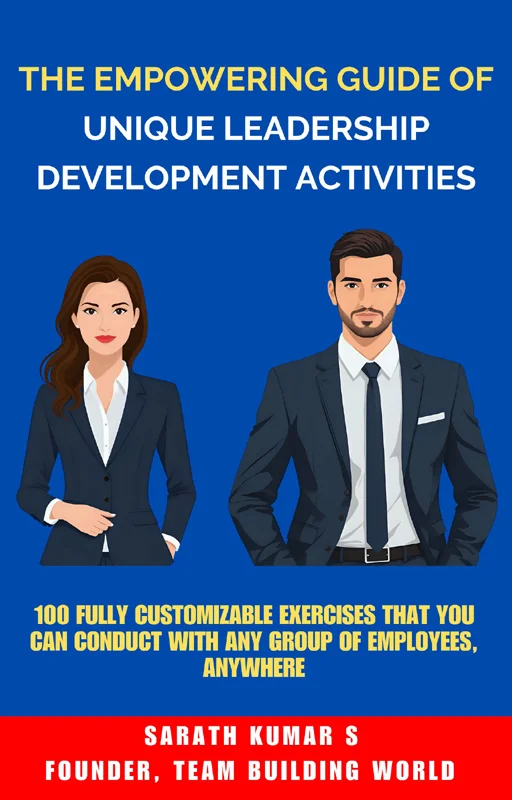The 5 Leadership Development Stages in the Modern Day
Do you want to know about the leadership development stages in detail?
Leadership is a skill that evolves over time, shaped by experiences, learning, and self-awareness. If you want to build leaders at all levels in your organization, it’s essential to understand the stages of leadership development.
In this article, let’s see the five key stages of leadership development in the modern day. These stages can serve as a framework for organizations to create effective leadership training programs.
Why is it Important to Develop Leaders in Your Organization?
Developing leaders within your organization is critical for fostering growth, innovation, and resilience. Effective leadership ensures that teams are well-guided, challenges are addressed strategically, and long-term goals are achieved. Developing leaders can benefit your organization in the following ways:
Improved Decision-Making
Strong leaders possess the ability to analyze situations effectively and make informed decisions, leading to better outcomes. This minimizes risk and creates a culture of trust as well as reliability across the team.
Enhanced Employee Engagement
Leaders who support their teams boost morale and create an environment of motivation. Engaged employees are more likely to be productive and committed to organizational success.
Increased Adaptability
Organizations with well-trained leaders can respond to challenges and changes with agility. Effective leaders guide teams through uncertainty, maintaining focus and stability.
Strengthened Organizational Culture
Good leadership helps cultivate a positive and cohesive work culture that aligns with company values. It fosters collaboration, transparency, and a unified sense of purpose.
Talent Retention and Development
Investing in leadership development shows employees they are valued and encourages them to stay. It also helps identify and cultivate future leaders, ensuring long-term organizational growth.
Enhanced Innovation
Empowered leaders promote creativity and encourage innovative thinking within teams. This leads to fresh ideas and solutions, keeping the organization competitive in a rapidly changing market.
The 5 Leadership Development Stages in the Modern Day
Here are the five key stages of leadership development in the modern day.
Stage 1: Self-Awareness
In this stage, individuals focus on understanding their strengths, weaknesses, values and purpose. Self-awareness is the foundation of effective leadership. By understanding your thoughts, emotions, and behaviors, you can make more intentional decisions as well as foster stronger relationships. So, consider these things:
Reflect on Your Strengths and Weaknesses
Take time to evaluate what you excel at and where you can improve. This honest assessment allows you to build on your strengths and address areas for growth.
Seek Feedback from Others
Ask for constructive feedback from colleagues and mentors. External perspectives can reveal blind spots and help you grow as a leader.
Practice Mindfulness
Focus on staying present and aware of your thoughts as well as feelings. Regular mindfulness practice sharpens emotional intelligence and reduces reactive decision-making.
Identify Your Triggers
Understand what situations or behaviors provoke strong emotional responses. Recognizing your triggers helps you manage reactions effectively.
Align Actions with Values
Clarify your core values and ensure your actions reflect them. This alignment builds integrity and guides consistent behavior.
Keep a Journal
Document your daily experiences, decisions, and reflections. Journaling provides insights into patterns and helps track personal growth over time.
Stage 2: Skill Development
In this stage, you actively work on developing leadership skills. Skill development is an essential step in achieving personal and professional growth. By focusing on targeted areas, you can build proficiency and unlock your full potential. Here are the things you should consider:
Develop a Growth Mindset
A growth mindset embraces challenges and views failures as opportunities to learn as well as improve. By adopting this perspective, you can foster resilience and continuously enhance your abilities.
Cultivate Time Management
Learn to prioritize tasks and allocate time effectively. This reduces stress and ensures productivity in both work as well as personal life.
Improve Communication Skills
Practice active listening and clear expression of ideas. Strong communication fosters better relationships and collaboration.
Enhance Problem-Solving Abilities
Approach challenges with a solution-oriented mindset. This helps you think critically and make sound decisions under pressure.
Foster Emotional Intelligence
Understand and manage your emotions while empathizing with others. Emotional intelligence strengthens interpersonal connections and teamwork.
Strengthen Adaptability
Be open to change and willing to adjust to new situations. Flexibility allows you to thrive in dynamic environments.
Build Technical Proficiency
Invest in learning technical skills relevant to your field. Mastery of tools or technology enhances competence and career opportunities.
Stage 3: Real World Application
In this stage, you put all your skills and knowledge into practice. You apply what you have learned in real-world situations, whether it’s at work, or in personal relationships. By actively engaging with challenges and refining expertise, you lay the foundation for long-term success. For this, follow these things:
Cultivate Regular Habits
Consistency is key to mastery. Develop routines that reinforce learning, making progress an integral part of your daily schedule.
Solve Real-World Problems
Practical application solidifies understanding. Use your knowledge to address real-world scenarios, bridging theory and experience.
Think Outside the Box
Creative thinking spawns new ideas and solutions. Embrace a diverse range of perspectives, exploring unconventional approaches to problem-solving.
Collaborate with Others
Teamwork fosters different perspectives and enhances problem-solving. Partner with others to learn collaboratively and expand your approach.
Reflect on Progress
Self-assessment highlights strengths and areas for improvement. Regular reflection ensures you remain focused on growth and development.
Adapt to Challenges
View challenges as opportunities to grow and innovate. Develop resilience by adapting your skills to overcome obstacles effectively.
Learn from Mistakes
Mistakes are inevitable, but they provide valuable learning experiences. Embrace mistakes and use them as opportunities to refine your skills as well as enhance your understanding.
Stage 4: Strategic Thinking
In this stage, you have developed a strong foundation of skills and knowledge. Now, it’s time to incorporate strategic thinking into your process. Strategic thinking involves analyzing complex situations, identifying potential roadblocks, and creating efficient solutions to achieve long-term goals. So, make sure you follow these things:
Clarify Your Vision
Define a clear and compelling vision to guide your decisions. A well-defined vision provides direction and aligns your actions with desired outcomes.
Set Priorities
Focus on the most critical tasks or objectives to allocate resources effectively. Prioritizing ensures you address what truly matters to achieve your goals.
Stay Focused on the Big Picture
Look beyond immediate results to consider the broader impact of your decisions. A long-term perspective helps you shape sustainable strategies.
Anticipate Challenges
Identify potential obstacles and develop contingency plans to overcome them. Anticipating challenges allows for proactive problem-solving and minimizes the impact of unexpected hurdles.
Collaboration is Key
Work with others to gain diverse perspectives and expertise. Collaborative decision-making leads to more well-rounded solutions and fosters a sense of team ownership.
Continuous Improvement
Regularly evaluate your decisions as well as processes, seeking ways to improve efficiency and effectiveness. Embrace a growth mindset that values learning from both successes and failures.
Stage 5: Leaving a Legacy
In this stage, you have gained extensive experience and have likely reached a senior position within your field. You may be considering legacy and what impact you will leave on the company or industry as a whole. This is also a critical stage for mentorship, as you have valuable knowledge and expertise to pass on to others. So, remember the following points:
Cultivating Future Leaders
Empowering future leaders ensures the organization thrives beyond individual contributions. Mentorship helps nurture talent and build confidence among emerging professionals.
Strengthening Organizational Culture
Focusing on values and shared purpose reinforces a cohesive workplace environment. This fosters collaboration and a sense of belonging, driving long-term success.
Building Resilient Systems
Establishing scalable processes and well-defined structures prepares the organization for growth as well as unexpected challenges. These systems provide stability and adaptability to sustain progress.
Promoting Knowledge Sharing
Encouraging open communication and documentation ensures critical expertise is not lost over time. This allows teams to learn from past experiences and innovate for the future.
Fostering Sustainability
Investing in sustainable practices secures resources and opportunities for future generations. This approach aligns organizational efforts with long-term environmental and social responsibilities.
Encouraging Lifelong Learning
Creating a culture of continuous development inspires individuals to improve their skills. This commitment to growth equips teams to stay competitive and innovative in evolving markets.
Want Some Unique Leadership Development Activities?
If you want some unique activities to equip your employees (both in-person and virtual) with leadership skills, qualities, and mindset, you can get my new e-book:
Or Want Some Unique Team Building Activities?
If you want some unique activities for your employees (both in-person and virtual), you can get my new e-book:
Final Words
Leadership development is an ongoing, dynamic process that adapts to the changing world we live in. Each stage provides unique opportunities for growth, shaping individuals into leaders who inspire, empower, and drive progress. Whether you’re just starting out or already in a senior role, understanding these stages can help you chart a purposeful and fulfilling leadership path. Leadership, after all, is not a destination—it is a lifelong pursuit. So, continue to develop your skills, knowledge, and mindset as you lead yourself as well as others towards success.
FAQ: Leadership Development Stages
You might have these question in mind.
What are some key characteristics of a successful leader?
A successful leader is someone who is able to inspire their team, while also being able to drive progress and achieve goals. They possess strong communication skills, emotional intelligence, and a growth mindset. They are adaptable and able to navigate through challenges with resilience. Additionally, they lead by example and continuously strive for personal as well as professional development.
How can leaders continue to develop their skills throughout their career?
Leaders can continue to develop their skills by seeking out learning opportunities such as workshops, courses, and mentorship programs. They can also reflect on their experiences and seek feedback from others to continually improve their leadership abilities. Lastly, staying current with industry trends and constantly adapting to new challenges will also contribute to ongoing growth as a leader.
How can understanding these stages benefit someone in a senior leadership role?
Even leaders who have reached senior positions can continue to learn and improve by understanding these stages. They can use this knowledge to reflect on their own journey and identify areas for growth or mentor others who are at earlier stages in their development. Furthermore, understanding these stages can help senior leaders anticipate challenges and proactively address them.
Can someone skip any of these stages in their leadership development?
It is possible for someone to have some level of skills or awareness in certain stages without actively going through each stage in order. However, each stage builds upon the previous one and skipping any can create gaps in a leader’s development. It is important to continually work on all stages to achieve well-rounded growth as a leader.
How can incorporating these stages into leadership training programs benefit organizations?
By incorporating these stages into leadership training programs, organizations can ensure that their leaders have a strong foundation and understanding of the different components of effective leadership. This can lead to better decision-making, communication, employee engagement, and ultimately, improved overall organizational performance.

